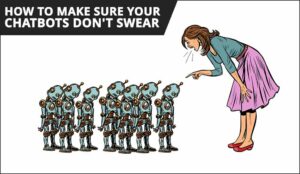Nuno Brito at Talkdesk shares insights on how customer service is being changed and improved by chatbots.
Customer service chatbots have entered the contact centre. They have the ability to positively impact customer service and uplevel the work that gets channeled to human contact centre agents.
Customer service chatbots can both improve customer service while simultaneously easing the burden on human agents.
What is a Customer Service Chatbot?
A customer service chatbot, sometimes called a virtual agent, is an application that runs automated tasks and simulates conversations with customers.
Many brands give their customer service chatbots human avatars and personalities—like the American Automobile Association’s “Miles” and Bank of America’s “Erica,” to name just two.
Chatbots are powered by artificial intelligence (AI) technologies like natural language processing (NLP), dialog control, and access to knowledge bases; they are trained using data captured in human-agent interactions with customers and often handle easy, frequently asked questions.
Chatbots are frequently found in web chat channels, but this functionality can be used in other digital channels such as social media, email, or voice self-service (where they can be referred to as voicebots).
In addition to handling frequently asked questions, customer service chatbots can serve as the first interaction with a customer, resolving the issue if it is within its knowledge base, and referring more complex interactions to a human agent.
This can have a significant positive impact on the customer experience without large investments in time or money.
More sophisticated chatbots use NLP and have the ability to ask questions to understand customer intent and improve the effectiveness of the interaction, and might also use machine learning to improve future outcomes.
Chatbots Should Help—Not Replace—Human Agents.
Any discussion of automation quickly brings up fears and questions about replacing human workers. To be clear, customer service chatbots are not deployed to replace human workers.
Customer service chatbots can be developed to help scale contact centre activity during spikes in call volume or to handle entry-level inquiries, free human agents for more complex issues, and achieve operational efficiencies.
A typical customer service chatbot experience could look like this: A customer finds himself locked out of his streaming video service and needs a password reset.
The chatbot is able to reference a knowledge base that includes the customer’s “secret questions,” compares the typed-in answers to validate that this is an authorized user of the account.
If the customer’s answers are validated, the chatbox sends a link or code to the user’s phone or email that will allow the customer to change his password to regain access to his account.
If the answers are not validated, the chatbot can let the customer know something has gone wrong and escalate the issue to a human agent, who will have more options to validate the customer and resolve the issue.
This is an example of a situation in which a chatbot can spare a contact centre agent from a repetitive call, freeing the agent for more complex and rewarding work, yet still bringing in a live person when the situation warrants.
The Benefits of a Customer Service Chatbot.
There are other benefits to employing a customer service chatbot outside of relieving contact centre agents from entry-level issues:
- Consistent customer experience. Chatbots are single-function applications programmed to do just one thing. Every customer is treated equally, but that doesn’t mean customer interactions will be robotic, boring, and stiff. The best automated service chatbots have the voice and personality of a brand, so customers feel like they are talking to a live agent.
- Improved response times. Automated customer service chatbots always deliver immediate responses and support, regardless of the volume of inquiries or time of day. Even in situations where chatbots are not able to fully resolve an issue, answering the customer’s inquiry immediately, rather than making them wait “on hold,” can prevent a customer from getting further frustrated or jumping to find an answer somewhere else.
- 24/7 availability. Customer service chatbots can be available around the clock. Unlike human agents, they don’t need to take breaks to eat or sleep. Customers can contact a brand at any time of day; chatbots will be there to answer their call.
- Operational efficiencies. Companies that deploy customer service chatbots can achieve significant operational efficiencies, including decreased compensation costs, reduction in physical real estate, more productive agents, and improved customer experience outcomes.
3 Ways a Customer Service Chatbot can Improve Your Customer Experience.
- Consistent brand interactions. The customer experience is defined as customer’s perceptions and feelings that result from interaction with a brand’s products and services. Customer service chatbots can ensure that customers have consistent brand interactions. Chatbots don’t have bad days or get frustrated; they can address customer interactions dispassionately, regardless of how worked up a customer might become.
- No missed steps. Customer service chatbots can also ensure that no steps are missed in the customer service workflow. Human agents are, well, human and might forget to save a detail about a specific interaction—and potentially risk a poor experience if the next agent the customer interacts with doesn’t have the latest information. Chatbots, on the other hand, are programmed to follow every process coded into their algorithm.
- Data collection and aggregation. A third way customer service chatbots can improve a brand’s customer experience is in the data they capture in each and every interaction. A contact centre can develop AI-driven tools that draw insights into customer preferences, needs, likes, and dislikes. This information, in aggregate, can lead to more intelligent decision-making on new products and services, customer marketing programs, and other activities that can improve the overall customer experience.
As contact centres continue to deploy customer service chatbots, they are becoming more sophisticated, answering higher-level issues and challenges. While there will always be a need for human agents in the contact centre, customer service chatbots are here to help lighten the load.
This blog post has been re-published by kind permission of Talkdesk – View the Original Article
For more information about Talkdesk - visit the Talkdesk Website
Call Centre Helper is not responsible for the content of these guest blog posts. The opinions expressed in this article are those of the author, and do not necessarily reflect those of Call Centre Helper.
Author: Talkdesk
Published On: 18th Jun 2021
Read more about - Guest Blogs, Talkdesk






 Talkdesk is a global customer experience leader for customer-obsessed companies. Our contact center solution provides a better way for businesses and customers to engage with one another.
Talkdesk is a global customer experience leader for customer-obsessed companies. Our contact center solution provides a better way for businesses and customers to engage with one another. 































